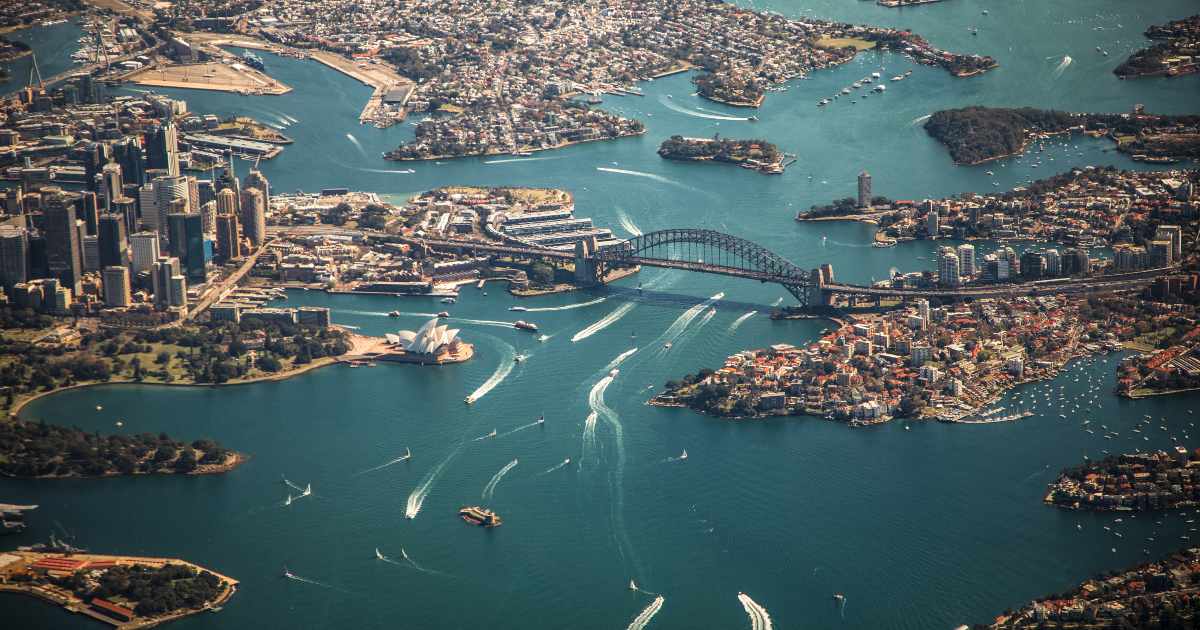When is the best time to visit Australia and Oceania?
In Australia, November to March is perfect for the coast, while the southern regions are best from October to April. New Zealand enjoys a mild climate, making spring and summer (September to February) ideal for travel. The Pacific Islands, including Fiji, Samoa, and Tahiti, are most pleasant from May to October during the dry season, when the weather is calm and sunny.
How to get to Australia and Oceania?
Major international airports include Sydney, Melbourne, Brisbane, Auckland, and Nadi (Fiji). Airlines like Qantas, Air New Zealand, Singapore Airlines, and Emirates connect the region with Europe, Asia, and the Americas.
- Key airports: Sydney Kingsford Smith, Melbourne Tullamarine, Auckland International, Nadi International.
- Flight times: London to Sydney (22 hours), Singapore to Brisbane (8 hours), Los Angeles to Auckland (13 hours).
- Common stopovers: Dubai, Doha, Hong Kong, Singapore.
- The Pacific Islands are linked by cruise routes from Australia, New Zealand, and Hawaii.
- Sydney, Brisbane, and Auckland are the main ports for international cruises.
- Australia and Oceania are not connected to any other continent by land, so access is only possible by air or sea.
How to travel within Australia and Oceania?
Within Australia, domestic flights are the fastest option, operated by airlines such as Qantas, Jetstar, and Virgin Australia. Trains and buses serve shorter routes, while renting a car is the best way to explore national parks and coastal roads.
In New Zealand, driving or traveling by campervan is the most scenic option, offering stunning views of mountains and lakes. The Pacific Islands rely on domestic flights and ferries for inter-island travel. On smaller islands, taxis, bicycles, and scooters are common. Air Tahiti Nui, Fiji Airways, and Air Niugini provide regular regional connections.
Top destinations in Australia and Oceania
Australia’s highlights include Sydney, Melbourne, and Brisbane, as well as iconic natural sites like the Great Barrier Reef, Uluru, and Kakadu National Park. New Zealand impresses with the Southern Alps, Lake Wakatipu, Lake Taupo, and cities like Auckland and Queenstown.
In the Pacific, Fiji, Samoa, Tahiti, and the Cook Islands feature white-sand beaches, coral reefs, and friendly locals. Papua New Guinea and the Solomon Islands offer untouched wilderness and traditional cultures. Across Polynesia, Micronesia, and Melanesia, travelers can discover both luxury resorts and remote islands untouched by modern tourism.
Accommodation across Australia and Oceania
In Australia and New Zealand, travelers can choose from five-star hotels to budget hostels, with prices from €30 for dorm beds to over €200 for luxury stays.
Food and cuisine in Australia and Oceania
Australia’s food culture features fresh seafood, barbecue, and multicultural dishes. Signature meals include meat pies, barramundi fish, and pavlova dessert. New Zealand is known for lamb and green-lipped mussels, while Pacific Islands specialize in dishes made with coconut milk, taro, and tropical fruits.
Fiji and Tahiti focus on seafood and rice-based meals, often cooked in banana leaves or underground ovens. Major cities offer a global dining scene, with everything from Italian and Japanese to contemporary fusion cuisine.
Culture and people of Australia and Oceania
Aboriginal culture in Australia and Māori traditions in New Zealand play a vital role in national identity. Across Polynesia and Melanesia, music, dance, and rituals are central to community life.
The people are known for their friendliness and laid-back lifestyle. Festivals such as Sydney Mardi Gras, the Pasifika Festival in Auckland, and Heiva in Tahiti showcase the region’s vibrant spirit. The mix of modern living and ancient customs creates a unique cultural atmosphere.
Geography and climate
Australia features deserts, rainforests, and vast coastlines, while New Zealand is known for its mountains, fjords, and rolling hills. Oceania is made up of thousands of islands spread across the Pacific, from volcanic peaks to coral atolls.
The climate ranges from tropical in the north to temperate in the south. In Australia, summers are hot (up to 35°C), while winters are mild. The Pacific Islands enjoy stable temperatures between 25°C and 30°C all year. Cyclone season runs from November to April, but the rest of the year brings calm, sunny weather.
Useful travel information
- Visa: Electronic visas (ETA/eVisitor) are required for Australia and New Zealand.
- Currency: Australian Dollar (AUD), New Zealand Dollar (NZD), Fijian Dollar (FJD), CFP Franc (XPF).
- Safety: The region is generally safe, though weather conditions can change quickly.
- Health: Tap water is safe; no major health risks.
- Transport: Flights, ferries, and car rentals are the main travel options.
- Emergency numbers: 000 in Australia, 111 in New Zealand.
- Regional organizations: Pacific Islands Forum, ANZAC community.




